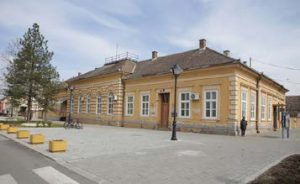Jabuka (English-Apple,Hungarian – Torontálalmás, German – Apfeldorf) is a village located in the territory of Pančevo, in the South Banat District of the Autonomous Province of Vojvodina. According to the final results of the population census in 2011, there are 6181 inhabitants in Jabuka. Jabuka is now unofficially known as a settlement in Serbia with the highest percentage of ethnic Macedonians and as their important cultural center in Vojvodina.

The first written data date back to 1385. Jabuka was founded by Serbian fishermen who found an apple tree on the left bank of the Tamiš and built the first houses under it. According to the data from the distant 1928 year, in the prehistory in this area there was a settlement with two developmental periods (Vinčanska and Starcevka culture). It is safe to say that between 1660-1666. Apple did not exist as a populated place. After the great migration of Serbs in this region, the Serb population is again settled along with a part of the Macedonian settlers. In the time of Maria Theresa of 1763, and especially in 1765 and 1766, the German colonization of Jabuka was carried out. The oldest monument in Jabuka is a large stone cross, which is still located in Zarka Zrenjanin Street, dating back to 1788, and according to historical data, those who fleeing from Turks have returned to Jabuka happily. In the time of Austro-Hungarian rule in these parts, the city gets its wet look as it is today. In 1901, the chapel of St. Dimitrium was built, built by members of the Romanian Orthodox Church, which until now are used by everyone in Jabuka. In 1912, Elementary School was built and until the Second World War, Apple has the status of the Municipality.
Between the two world wars, despite being immigrated from Lika, Bosnia and Montenegro, the German population remains the most numerous. At the beginning of 1925, the agricultural cooperative was also registered. When it comes to the Second World War, Apple is named (Mayor “Torontálalmás”) (German Apfeldorf) From 1941 to 1944, at the site of the Defense, more than ten thousand Serbs, Roma and Jews were killed by the order of the Pančevo police chief. In 1945, a pyramid memorial was built, and in recent times a large monument with a memorial house. In 1945, the colonization of Apple began.
Families with only the most basic means of living arrive from all parts of the former Yugoslavia. The most colonists are from Krivopalanacki as well as other parts of Macedonia. They adapt to life in the plain and, along with old-colonists and colonists from other parts of Yugoslavia, begin to build a newer history of Apple.
